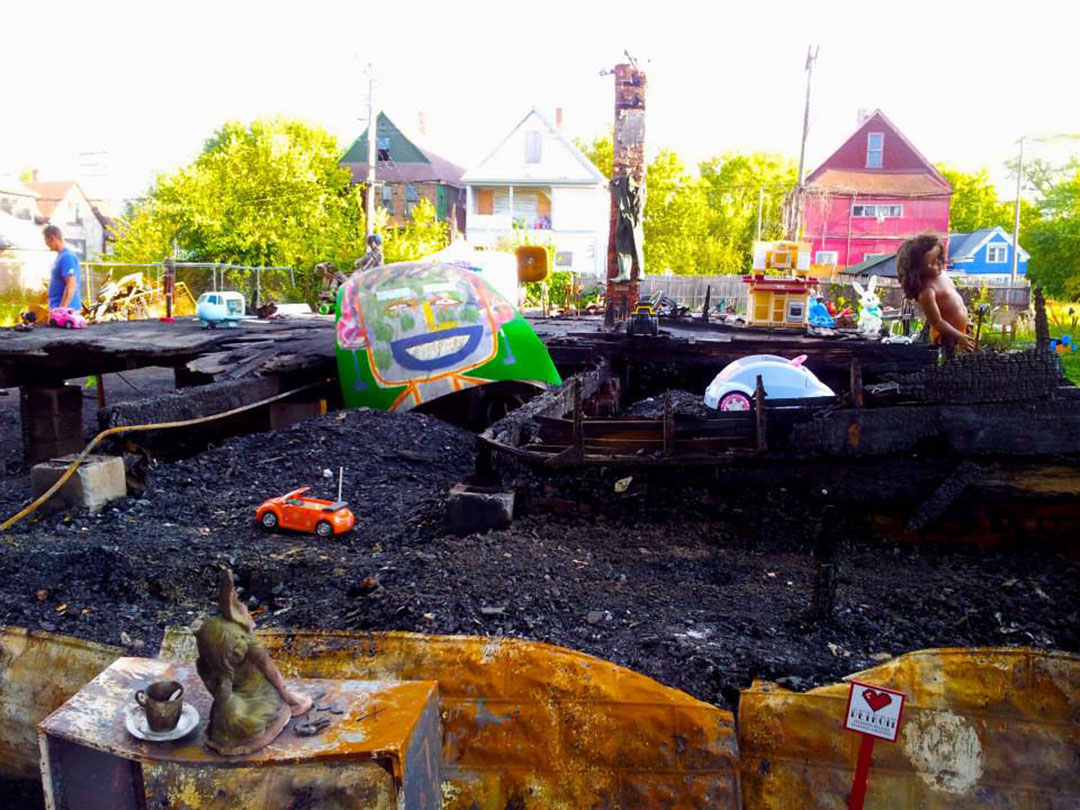
"God gave Noah the rainbow sign,
No more water but fire next time"
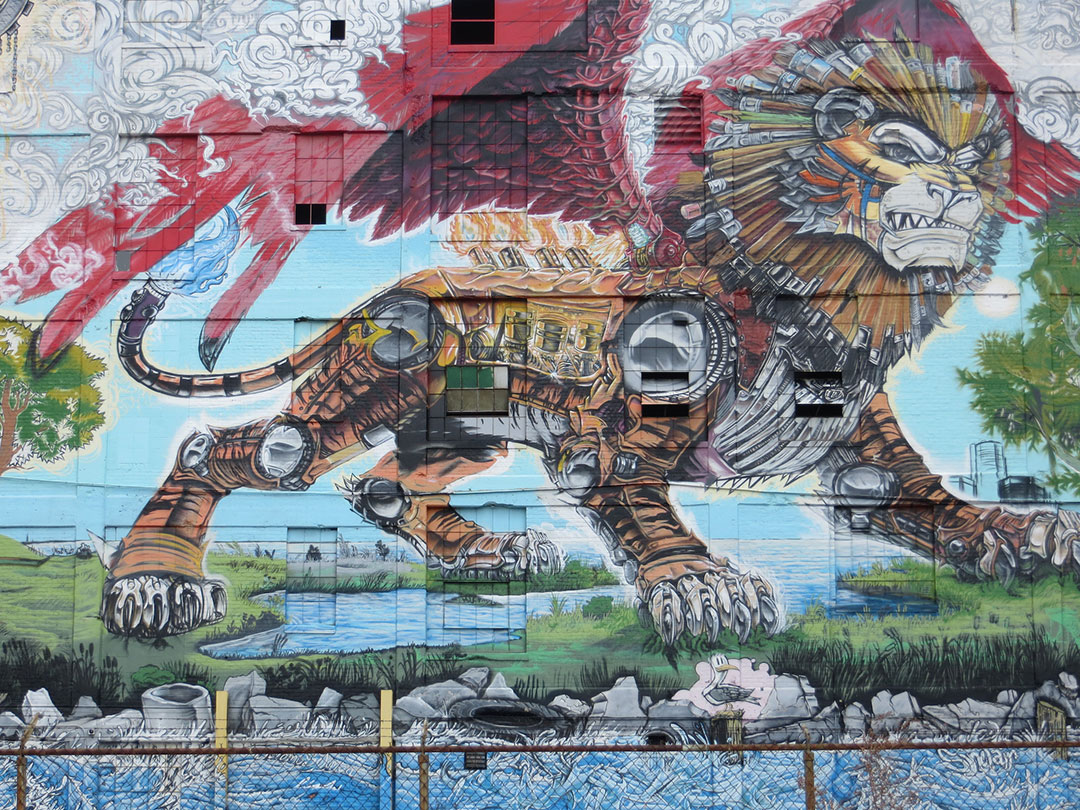
In October, John takes me to see the chimera up close. We try to pull up next to the building but realize it’s a one-way street and end up detouring around Detroit, moving in and out of Corktown. I see Michigan Central Station, a must-do on unofficial blight tours of the city. It’s a beautiful structure, designed by the same firm that created Grand Central Station in New York. You can see it from I-94 as you enter downtown. Its broken windows glitter with bits of leftover glass. Something about the way light dies as it finds the empty window sockets seems especially shocking.
We finally get back to the street behind the chimera mural, which takes up the entire west-facing wall of the Russell Industrial Center. Homer called the chimera "a thing of immortal make, not human, lion-fronted and snake behind, a goat in the middle and snorting out the breath of the terrible flame of bright fire." Detroit's massive chimera reminds me a bit of the ancient mythical creature Homer imagined. Wings let the lion take flight, claws and teeth make powerful weapons, and the metal bits, the robot joints, lend strength and durability. Somehow, all the disparate bits work together, making a cohesive, useful and harmonious whole.
Detroit has many working pieces, so many neighborhoods and types of people that it makes sense for the chimera to act as a grand symbol of civic unity. I like it better than the phoenix, partly because the whole rising-from-ashes thing feels played out and sad. It assumes that Detroit exists as some kind of ruin and owes the rest of the country a second act, some fake, uplifting gesture that acknowledges and overcomes ruin, horror and poverty.
I reject these ideas — at least as far as I’m allowed to reject anything on behalf of a city I barely live in. I see the city as recreating itself rather than rising from ash, though I know that fire has played a part in its history for more than a hundred years, from the Great Fire of 1805, to the devastation of so many Devil's Night conflagrations to the more recent burning of crack houses by vigilantes.
In 1805, shortly after the city’s centennial, a fire started by a baker’s careless pipe smoking destroyed the entire city, save for a stone fort and some brick chimneys. At the time, Detroit had no fire department, and attempts at forming a bucket brigade to pass water from the Detroit River to the burning wooden homes and businesses failed utterly. While no one died in the fire — a minor miracle — the city needed rebuilding. Augustus Woodward, a local judge, had a major hand in one legacy of the fire: the city’s spoke-like street system. Woodward designed it himself, basing his plans on Washington D.C. Some of the streets built as a result of the 1805 fire remain today: Michigan Avenue, Grand River, Fort Street, Woodward, Gratiot and Jefferson. Sadly, the city carries on another 1805 tradition, that of inadequate funding to fire services. In 2012 alone, Detroit closed 15 firehouses and demoted nearly 200 firefighters, leading their union president, Dan McNamara, to comment, “The city has essentially said ‘I think everybody better make sure they have their own garden hose.’”
My own recent history with Detroit began with fire. A year before my visit to the chimera with John, I was driving in to research the Heidelberg Project, a nearly 30-year-old folk art environment on the city’s East Side, when I passed a wreck on I-75. The scorched remains of the van, a mid-’90s Aerostar, lay smoldering amid a collection of brightly burning police flares. I passed the wreckage and looked up at the red deco sign atop the Ambassador Bridge, the great cabled behemoth that links Detroit to Windsor, Ontario. As many times as I've driven to Detroit, I'd never looked at the bridge for more than a few seconds. Just after the bridge, I noticed the chimera looking down on the highway.
In May, after an arson at the building dubbed "Obstruction of Justice" (or “OJ” House) by Heidelberg Project Founder Tyree Guyton, I visit and take a picture of the home's burned facade. The porch still bears many of the emblematic objects I remember from before the fire: a bathrobe, several broken televisions with the word "God" painted on their screens, a derelict payphone. I walk towards Whatty Dotty, the white house whose gaily painted polka dots have become synonymous with Heidelberg. As I pass OJ, I see a short, black man in coveralls and work gloves. I wave and walk over to introduce myself.
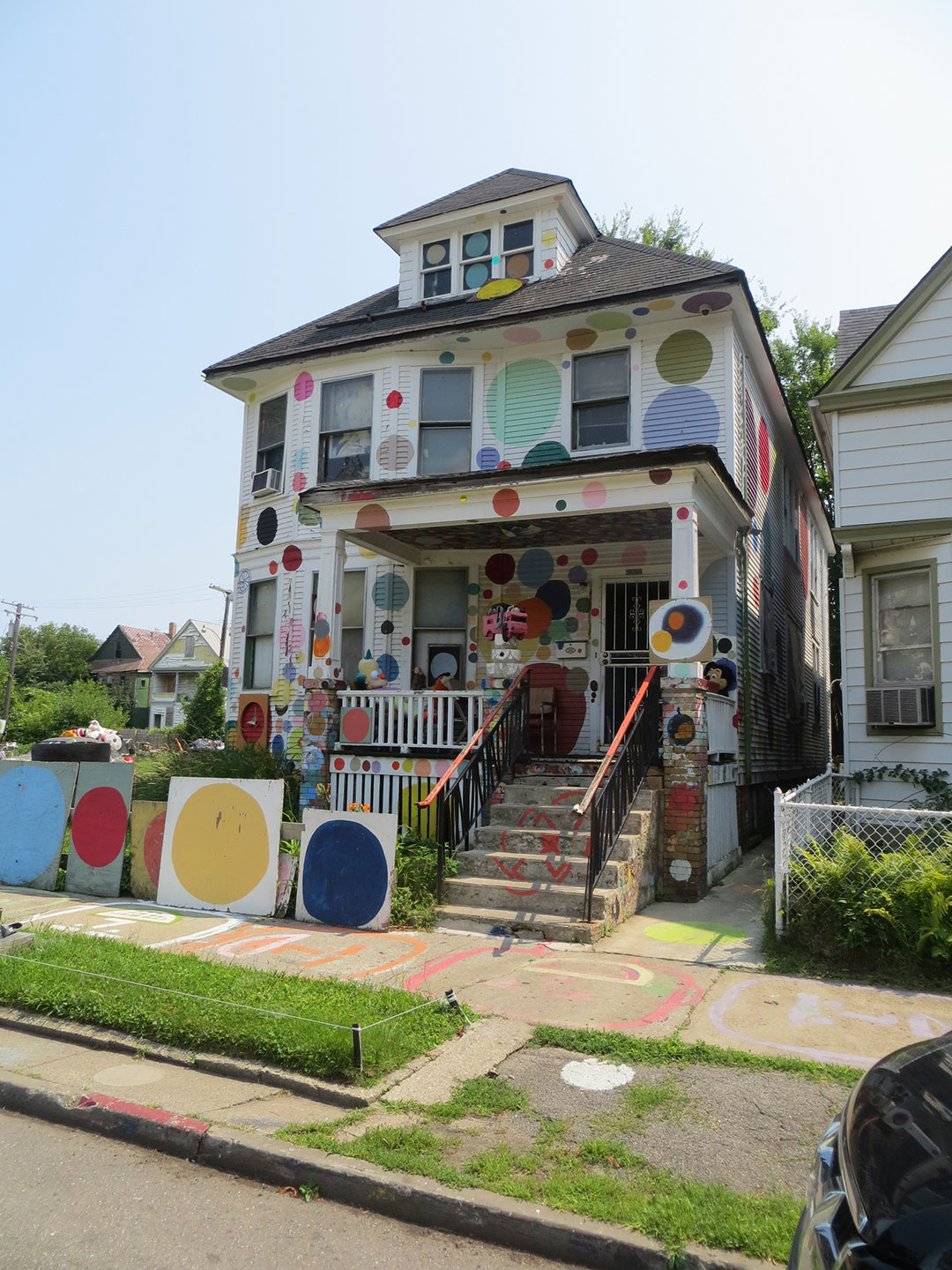
I extend my hand, and he removes a work glove and wipes the dirt off his small, hard palm before we shake.
“Eddie,” he says, by way of introduction. "Are you here taking pictures?"
"Yes and no," I reply. "I'm mostly here to write. I'll be around a lot this summer." He nods. He is thin and slight, maybe 5'4 or so, and I can't tell how old he is. He asks again about pictures. "I took one of the front," I tell him.
He shakes his head. He gestures for me to follow him. We walk around to the exposed, open side of OJ House. He points to a large banner strung across the burnt remnants of the living room; it reads "1967." I see a doll with a happy grin seated in a pink chair, as if awaiting the attentions of a salon professional. Her brown cheeks stretch in an exaggeratedly happy smile. I realize that the burned living room is the first interior space I've seen at Heidelberg. Its ruined emptiness offers few clues to what a family living here would have experienced. I ask Eddie if Heidelberg will keep the burned pieces, and he shakes his head.
"I'm putting all that in a dumpster," he tells me, gesturing widely to indicate the blackened timbers and pieces of old roofing. I notice an assortment of old vacuum cleaners arranged in a careful circle behind the house.
"I did that yesterday," he tells me. I'd expected to see rebuilding efforts, but something about that clump of vacuums unsettles me. The pace of change and rebirth at Heidelberg sometimes feels overwhelming — of course, the pace of decay in so many other blocks of Detroit overwhelms me, too. I think about the tall grass in blocks that have gone back to nature, the hundreds of pheasants who now live in abandoned streets in the city center and the urban game restaurant Detroit police declined to deal with, citing things like arson as more pressing.
I considered the idea of fire as cleansing. Police suspect arson in the OJ House fire, though I cannot imagine why anyone would burn part of Heidelberg. I'd heard rumors that residents on more populated blocks in Detroit have gathered en masse to burn abandoned houses where people bought and smoked crack or shot heroin.
"What about the addicts?" I asked John, who'd recounted one of these urban revenge fables.
"I think they escaped," he said.
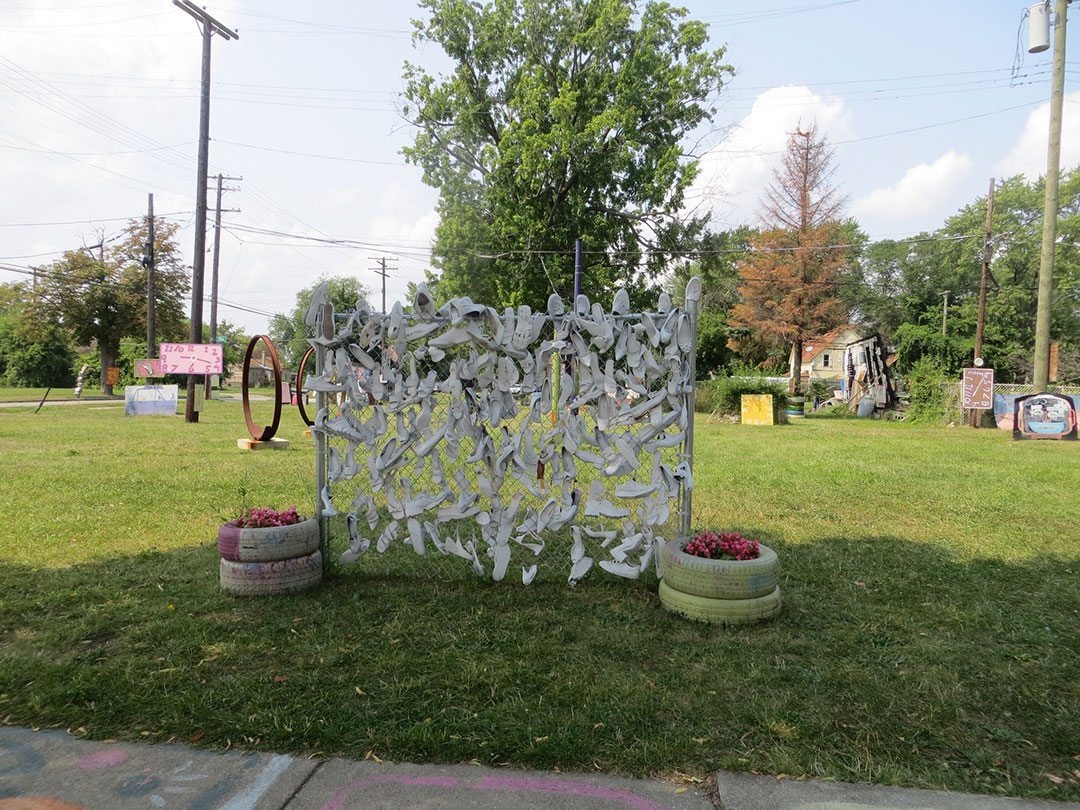
Months after meeting Eddie, I return to Detroit to visit John. After we check out the chimera, we head east to see if there’s anything new at Heidelberg. The sun is bright. It's a perfect October day, warm and clean. John and I walk down the street, and I notice new additions: a fence adorned with white-painted shoes; a doghouse the size of a Humvee; benches in golden oak, decorated with orange dots. We get to OJ House, and I gasp.
"You didn't know?" John asks. The last time I saw OJ House, Guyton had spent the summer rehabbing it. Though burned and buckled, the structure stood, covered in new sculptures and paintings. John explained that in October, just before my visit, someone torched it again, leaving only a blackened foundation, strewn with ash. This fire burned fiercely, even scorching the trees in front of the building. The trees' flesh shows through now, shockingly golden against the charred bark. I smell smoke. The bare foundation looks like a theater stage. It is incongruously clean. I see a painting in the center, an abstract head in blue and red, with a large, smiling mouth. In the dirt in front of the foundation, I see a tiny red-and-white sign with a heart, the word "Detroit,” and the phrase “Speramus Meliora; Resurget Cineribus" — the city’s Latin motto, which translates to “We hope for better things; it will rise from the ashes.”
A few weeks later, I'm back in Wyoming, where I teach freshman composition. I check my Facebook page and see a link my friend Michelle posted to my wall. The headline: "Heidelberg Project's 'House of Soul' Destroyed by Fire."
During one July trip to Heidelberg, just a few weeks after meeting Eddie, I explored House of Soul in detail, mostly because I’d decided to look specifically at places at the site that included the word “God.” On the way there with my friend Becky and her toddler, I begin to count churches. I see Mt. Zion Church, the Neapolitan Church of Deliverance, Sacred Heart Church, Bethel Church of the Apostolic, the Pearly Gate Missionary Baptist Church, the Jamison Temple Baptist Church, Divine Church of Mental Science and (my personal favorite) Doers of the Word. Just before we arrive at the Heidelberg Project, on Mt. Elliot Street, I see something called the Kabaz Cultural Center, which looks like a church, too. Its dedication to "Queen Mother Nora Williams" gives me pause. When I research it later, I learn that Nora Williams lived to age 103, that she wore high heels until sometime after her 100th birthday and that she'd presided over children's activities at that center for decades.
Later, when I talk to Cynthia Holloway, who is 102 herself and a 60-year resident of Heidelberg Street, she tells me that family life in the neighborhood used to center on church. Sundays, people dressed up. They walked to church or rode in cars – American cars made in the factories that employed the street’s husbands and fathers and even some of the wives. Holloway’s husband worked for Cadillac and drove a Cadillac.
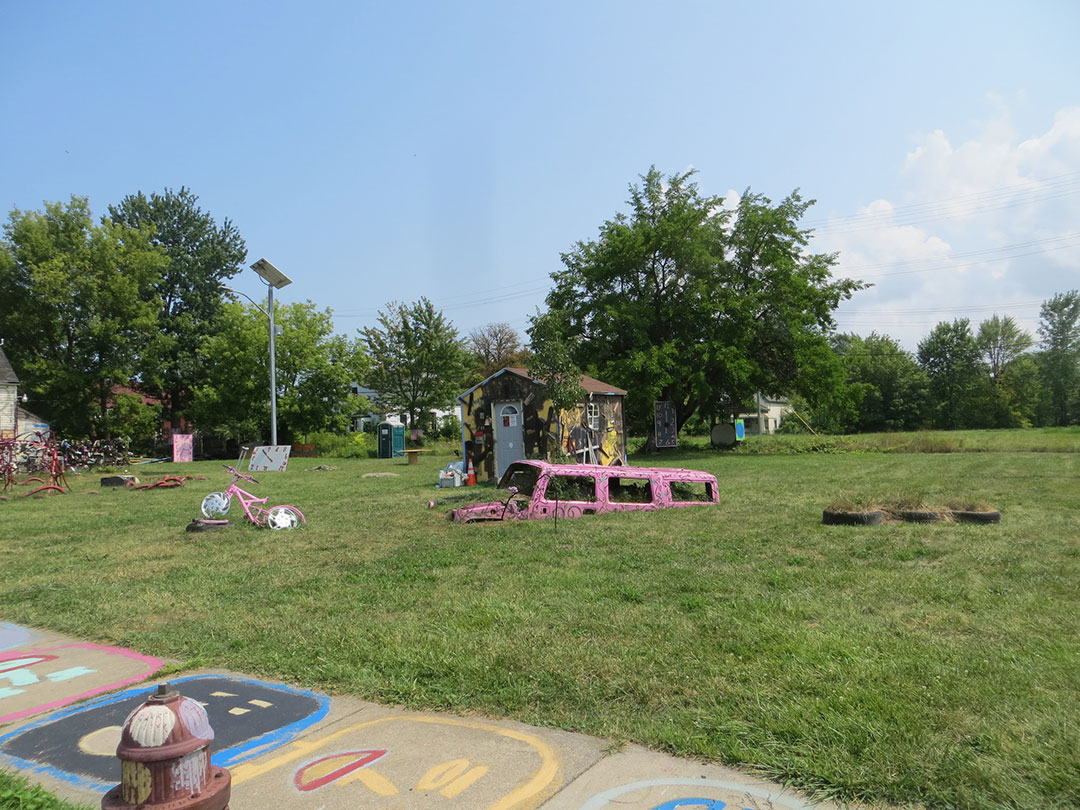
On Sundays, I still see crowds of people outside the churches on Mack Avenue. Women dress up, some wear large hats. Men wear suits and ties, their couture ranging from humble to a level of brilliant sharpness that could rival Prince’s performance wardrobe. Whenever I drive by the churches, I consider attending a service. I think about the last time I went to a black church. My Big Brothers/Big Sisters little sister had a solo with the choir at a Baptist church in Toledo. I arrived at 9 per her instructions, having no idea that actual services began at 10; only the churchiest of church ladies appeared at 9 to get their pray on. When it came time to speak in tongues, I froze, eventually mumbling the bits of Kaddish I could remember. I was only trying to be polite.
When I researched the churches, I noticed that the Kabaz Center's Facebook page had many pictures of Heidelberg Project, including one of Tyree working. I reminded myself I came to Heidelberg Project that day to look for God, and I found him again near the site’s central green space on a large board painted with the words "New York Taxi.” The car on the board aims vertically, poised to drive into the bright blue sky. The word "God" runs over top of the taxi, and I wonder if God is a person or a destination.
As I walk on with Becky and her son, a little girl in a turquoise T-shirt watches from the window of one of the inhabited homes. She watches solemnly, but smiles as she spies Billy in his Angry Birds T-shirt. She waves from the window, and Billy waves back. We round the corner of the block and lose sight of her, though we pass by her front porch. It lacks the obvious touches of outsider art other Heidelberg Project-area homes have but is instead adorned with a wild mass of climbing primroses in a magenta as crazily bright as any of the man-made decorations on the street.
At House of Soul, I catalogue the records. Because Heidelberg Project stands in the heart of Detroit, I always thought I'd see Sam Cook, Stevie Wonder or the Supremes. The discs all had colorful centers — red, blue, yellow, orange — but the music they held could not have been any whiter. "Lawrence Welk,” I read aloud. "Jane Fonda's workout record?" I see many Reader's Digest discs. The side of the porch reads "God" in red, with a record album as the "O."
Billy has no patience for my note-taking. He drags me over to a brightly painted swing set. There's a park at Heidelberg, shaded by a huge mulberry tree. Becky grabs a few ripe berries, and Billy and I eat them. Billy scrambles happily up the side of a purple climbing structure, and I rest on a bench.
The berries taste sweet, a little citrusy and a little earthy. The playground has many taxi signs. The painted plywood plaques surround us, showing yellow cabs patiently waiting. I see crosses and dots everywhere. Billy runs up to me with his left shoe in hand. I help him put it on, lest it join the Heidelberg Project's permanent collection. Shoes, cabs, cars — all means of transit, all represent the freedom of movement. Where we're going and where we've been seem especially relevant here.
We pause to talk to Tyree Guyton before leaving Heidelberg for dinner and air conditioning in the suburbs. He tells me that OJ House has a new name now.
"I'm calling it New Beginning," he says. He offers Billy a dry paintbrush and tells Becky to bring him on a Saturday, when he can paint for real. She agrees and tells Billy to say "Goodbye to Mr. Tyree." We get in my Saturn, pass five miles of rush hour traffic and find comfort in Starbucks, air conditioning and the unbroken hegemony of brick ranches and clipped green lawns in Madison Heights.
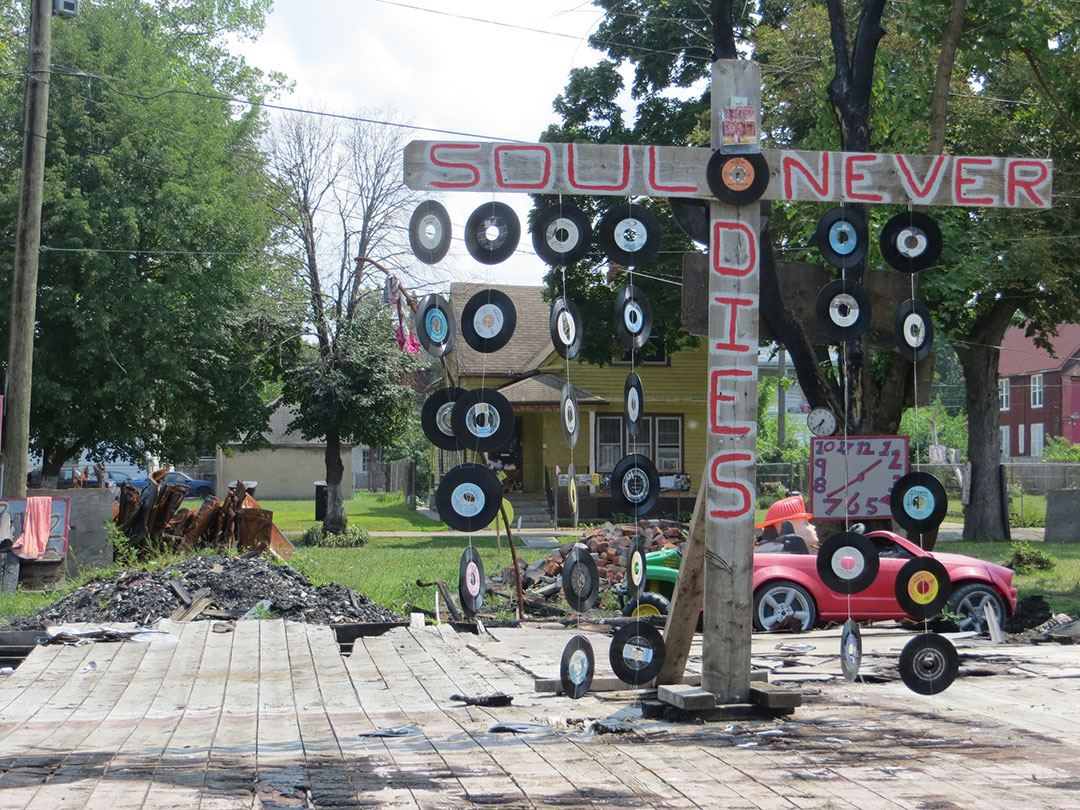
Months later, someone set a fire that utterly destroyed House of Soul. A week after that, someone burned the Penny House, a structure on Mount Elliot Avenue, directly across from Heidelberg Street. Jenenne Whitfield, Heidelberg's executive director, told me during the summer that the project planned to turn the Penny House into its headquarters. The first time I met with Whitfield, a striking woman with an intense gaze that seemed to peer into the least presentable parts of my soul, she showed me an architect's model of a future HQ. The building had sleek mid-century lines and a roof garden. I asked her about that model when we met in July, and she told me that Guyton had decided that he wanted to work with an existing building.
"He believes in reinvention and rebirth," she told me. "What better way can we embody that than by using a home already on the site?" Following that idea, Heidelberg had already had success turning the Number House into a visitor center and gift shop.
The Penny House had had a deep front porch and three stories of useable interior space, counting the attic. Just a few weeks after my October visit, someone set it ablaze, burning the 100-year-old structure that Tyree had adorned with large paintings of copper pennies, down to its red brick foundation. In December, as I read student papers about vaccination deniers and affirmative action, War House and the Clock House burned, too. When the Detroit News interviewed Guyton as he stood in the street tearfully watching as the flames consumed his art, he told the reporter, “In the words of Plato, I have to be quiet and still. I have to think.” He swore to keep the burned foundations as part of his work in protest.
Just before I left Detroit at the end of summer, I took my friend's three-year-old daughter to Heidelberg. We walked to OJ House, and I showed her the vacuum cleaner Stonehenge in its backyard. A naked, partly burned plastic doll dangled from one of the vacuums in the circle. Charlotte frowned at this.
"That's creepy scary," she said. She looked at the charred sides of OJ House and said my name loudly, like a magic word that summons genies: "Ree-beh-kah!!!!"
"Yes?"
"What happened to that house?"
"Someone tried to burn it down," I answered. "No one lived there," I added, hoping to reassure her.
I think about Charlotte’s question later, as I thumb through my ancient copy of James Baldwin’s The Fire Next Time. In it, Baldwin writes, “It is the responsibility of free men to trust and to celebrate what is constant — birth, struggle and death are constant, and so is love, though we may not always think so — and to apprehend the nature of change, to be able and willing to change. ... But renewal becomes impossible if one supposes things to be constant that are not — safety, for example, or money, or power. One clings then to chimeras, by which one can only be betrayed, and the entire hope — the entire possibility — of freedom disappears.”
This reminds me of the friend I lost recently because she thinks I’m naive about Detroit. That I don’t understand welfare cheats or that “good people” didn’t flee willingly to suburbs but were instead exiled by scheming poor people and incompetent officials. I don't know that we oppose each other at heart, though I tend to fall more in line with celebration, while she sees many terrible things as constants. She says I've clearly never dealt with people who have nothing but contempt for "whitey." We agree not only to disagree, but to never speak again, it seems. I have to accept this, because seeing temporary pieces of culture as constant or Detroit as a ruin betrays the possibility of change. I just don't want to do that. It feels too much like the moral equivalent of lighting a match and walking away.
I want the happy ending, or the next best thing, but I struggle for a while after I hear that Party Animal House burned, and six months later, I still don't understand it. The new trend on blogs in the city seems to be looking for ways to blame Guyton and Whitfield. Heidelberg Project raised $50,000 for improved security, and people wondered why they couldn’t protect Party Animal. They tried; they spent $18,000 on a security detail. Plans were also underway to install a solar-powered lighting system and stationary cameras.
Party Animal always moved me. It had a fun-house vibe and brought decay and innocence together in a way that both disturbed and charmed me. The green house covered in stuffed animals and large dolls drew Charlotte’s attention when we visited. She stood and stared at it, eyes wide and mouth open in surprise, for a good five minutes. She wanted to touch the animals, to count them, and begged me to take pictures.
When I explained that a person had set OJ House on fire on purpose, Charlotte couldn’t comprehend it.
"Why would someone do that?" she asked. "It's pretty here."
I told her I didn’t understand it myself.
Months later, I still don't understand. I like to think of Detroit as that chimera and of its different pieces and people as serving at least one shared goal: the resurgence of one of North America's oldest and best cities. The arsons confound that notion. I can't fathom them anymore than Charlotte could. All I can do is hope that better days are coming, and that Tyree Guyton, unbroken by this latest tragedy, will continue to make his piece of the city beautiful despite the scars newly burned into Heidelberg's heart.
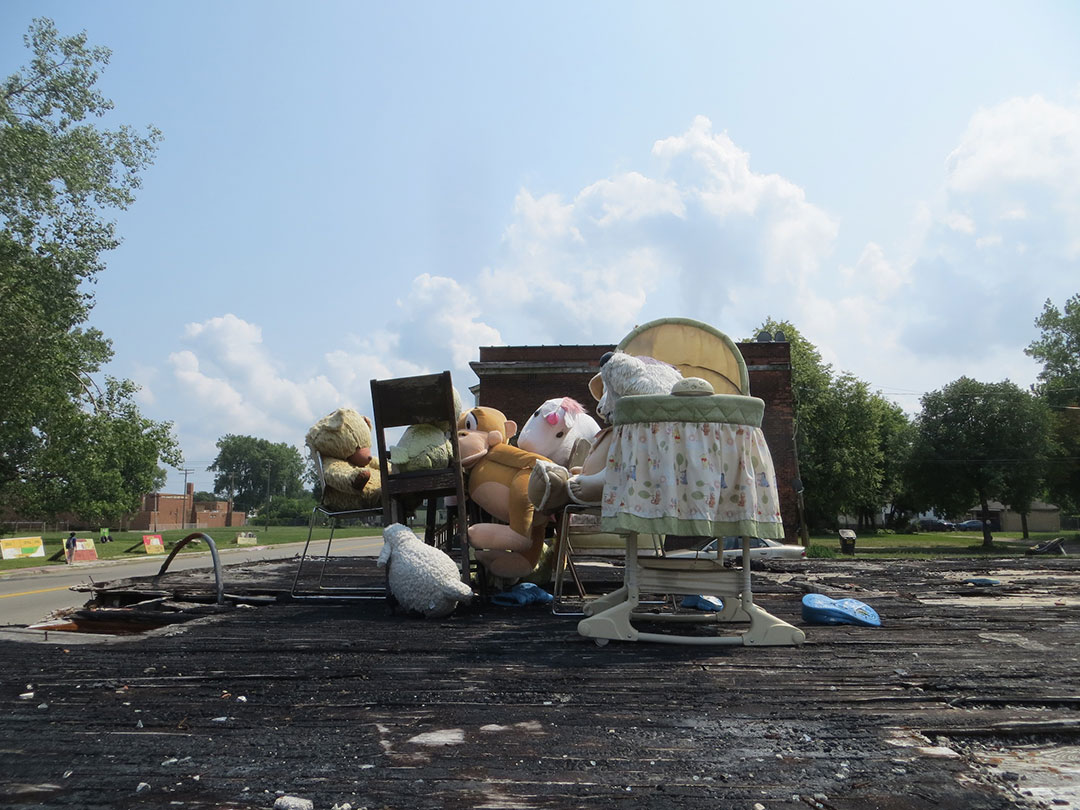
Rebecca Golden lives in Michigan, where she teaches composition. A graduate of the University of Wyoming MFA program in creative writing, her first book, Butterbabe, was published by Random House UK in 2009. She’s currently working on a memoir about Detroit, romance, pheasants, the Heidelberg Project and billboards for personal injury lawyers.